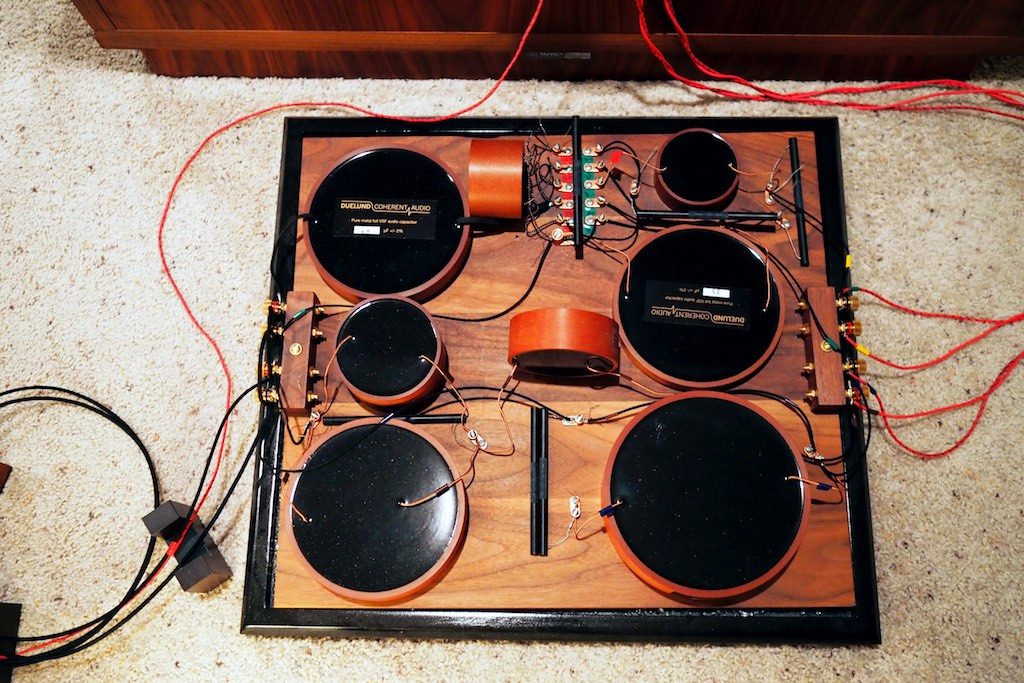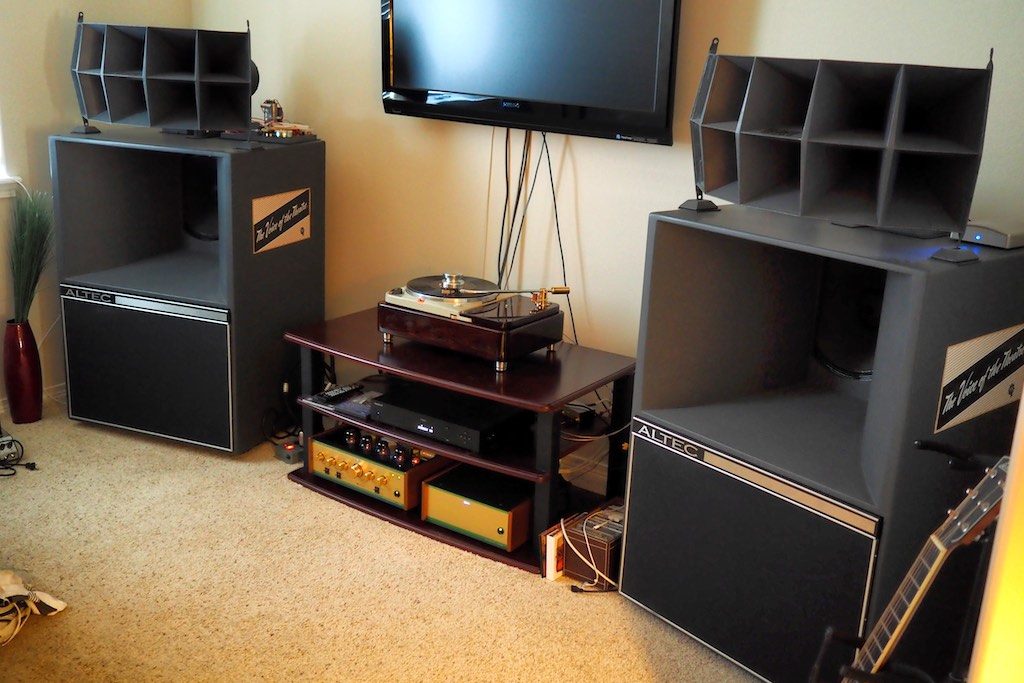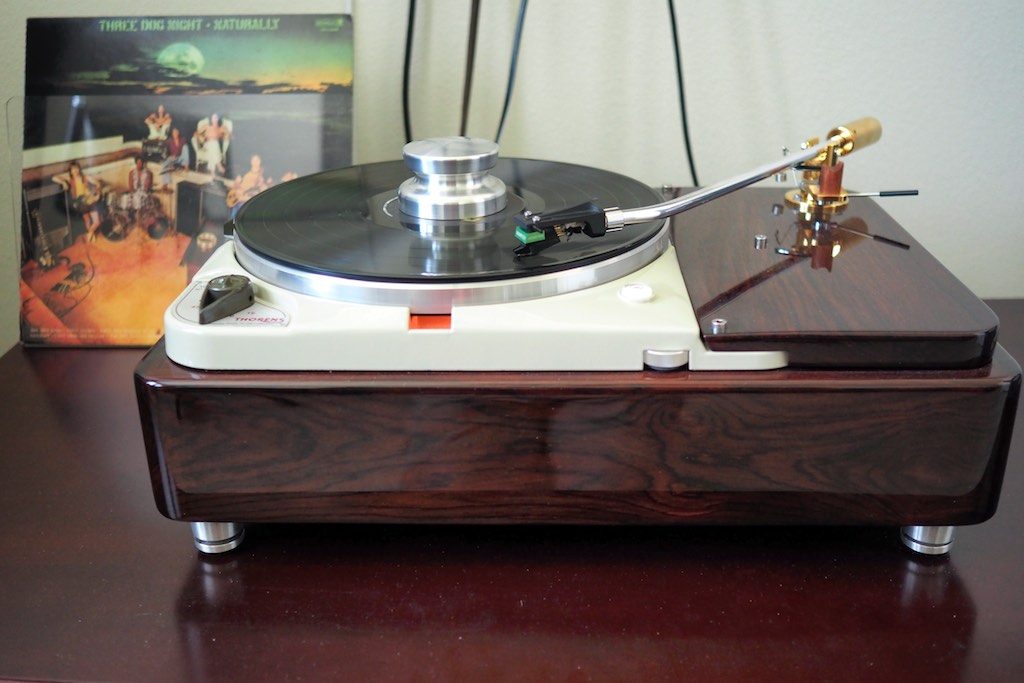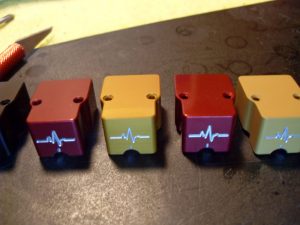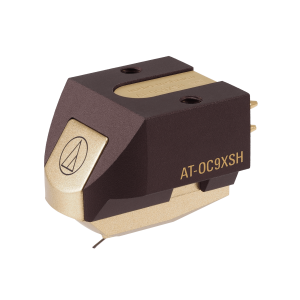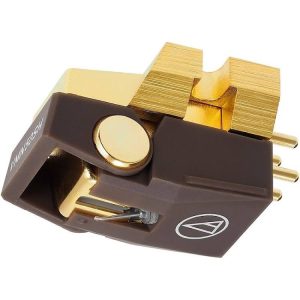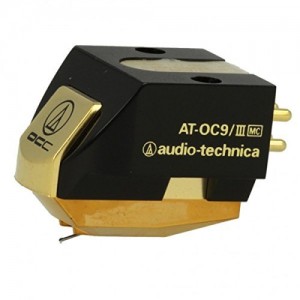The second system (above photos) consists of Tannoy Westminster Royal SE loudspeakers with external Duelund CAST crossovers, Duelund DCA12GA tinned-copper speaker cables, First Watt SIT-3 stereo amplifier (in for review), Duelund DCA20GA tinned-copper interconnects, vintage McIntosh MX110Z tuner-preamplifier, shielded Duelund DCA20GA tinned-copper interconnects from the MX110Z to bespoke Intact Audio nickel-core monaural step-up transformers, which connect to a Pete Riggle Audio Engineering 12.5-inch Woody SPU tonearm. The Woody SPU tonearm and a 12-inch Thomas Schick tonearm reside upon an Artisan Fidelity "Statement" dual tonearm plinth, which houses my Classic Turntable Company "Classic 301" (a very hot-rodded Garrard 301).
Listening Evaluations
Before I delve into my listening impressions with the Soundsmith Carmen Mk II on the above two systems, allow me to provide you an overview of what I listen for when I evaluate component performance during reviews, to help give you some additional context.
I find it useful to partition my perceptions into two broad (and somewhat overlapping) categories while listening: musicality and sonics.
The musicality aspect of a component's performance is related to its performance on the basic elements of music. I listen for how close a component comes to presenting recorded music realistically compared to live music, in terms of timbral realism (the unique 'voices' of instruments), the resolution of tone color (the ability to distinctly hear the chordal variations resulting from adding additional pitches to three tone triads), melody (the tune you 'whistle while you work'), harmony (treble & bass accompaniments to the melody), rhythm (the steady beat that determines the tempo), tempo (speed), dynamics (variations in loudness), and loudness (the ability to play naturally at live-like levels appropriate to a piece of music).
The second category of performance I listen for is sonics, which describes the performance of a component in reproducing the non-musical artifacts of the recording process, like transparency (the ability to 'see' into the recording), resolution (the amount of detail in the audio signal that is audibly presented), soundstage (the ability to discern the three dimensions of the recorded space in width, height and depth), the soundspace (the ability to convey the acoustic sense of 'space' of the recording venue), and imaging (the ability to localize instruments & musicians on the soundstage).
Finally, I listen for the ability of a component to integrate musicality & sonics in a way that maximizes an emotional response during the listening experience.
Regarding emotional response, researchers who study the neurobiology of music have found that certain elements of musicality and sonics reproduction stimulates emotional responses in the brain.
Their research suggests that a home music system that is capable of playing at realistic loudness levels, is dynamically realistic, and can realistically portray timbral textures, tempo, and beat, will be more emotionally engaging and musically satisfying than a home music system that can't do those things as well.
Also, researchers have found that the brain connection in the intraparietal sulcus does processing for both visuospatial processing and transposing melodies, which may help explain why some audiophiles get additional pleasure when that brain region is stimulated by processing recording artifacts containing visuospatial information, like imaging, soundstaging, and the sense of recorded space, which may co-opt the intraparietal sulcus in a way that increases the level of emotion experienced from recorded music.
If you are interested in learning more about how the neurobiology of musicality & sonics influences the music listening experience, search on "neurobiology" on my blog and read the various associated posts.
In simple experiential terms, I have found that if a given component overtly emphasizes sonic performance more than musical performance, it grows tiring for me to listen to before long, as it distracts me from the enjoyment of the music itself.
I have also found that if a given component overtly emphasizes musical performance more than sonic performance, I'll probably love the way it plays music, but over time I may miss hearing some of the finer recording cues that can add to the overall enjoyment of the recorded music listening experience.
I suppose that every hifi system and listener will be a little different in what they need and prefer to achieve for their perfect balance of musicality & sonics.
Listening Impressions
Let's start with my restored vintage Altec A5 Voice of the Theatre loudspeaker-based system first. The vintage Altec A5's are impressive loudspeakers that are surprisingly flexible and room friendly, given they were intended to provide ample sound that was specific to the needs of small-to-medium sized movie theaters.
To achieve that flexibility and room friendliness, the Altec A5's movie theater-style crossovers need to be replaced to adapt the big beasts to a domestic listening environment. With my Hiraga-inspired domestic-suitable crossovers voiced appropriately, the Altec A5 loudspeakers have adapted remarkably well to the rather small spare bedroom in my home that I use as an audio-video room, with dimensions of 11-feet x 12-feet x 9-feet (ceiling), with a 6' x 3'5" x 9' foyer on one end.
The big vintage Altec A5 Voice of the Theatre loudspeakers make movie soundtracks come captivatingly alive, sounding totally immersive and wondrous, and they are remarkably musical for music-only listening as well.
If someone tells you the big Altec A5 can't be stunning in small rooms don't you believe it—big vintage Altec's with appropriate crossovers and voicing have become my favorite small room loudspeakers!
I mounted the Soundsmith Carmen Mk II on a Thomas Schick graphite headshell with my Art of Tone DIY headshell leads (22GA tinned-copper), then installed it onto the Thomas Schick 12-inch tonearm that is on my Artisan Fidelity Thorens TD124 Statement Long-Base turntable.
I got the Carmen Mk II aligned correctly, set the azimuth, and dialed in the tracking force to a touch less than 1.6 grams.
I followed Peter Ledermann's advice on setting the cartridge's anti-skate, which you can watch two instructive videos about HERE.
Peter's method for setting anti-skate was new to me, so I was interested in giving it a try. It also happens to be the preferred method of tonearm designer Frank Schröder, as well as being rather easy to implement.
To get a feel for overall performance of the Carmen Mk II, I listened to a variety of jazz, blues, rock, pop, and classical albums, as well as to albums of male and female vocals that I enjoy, of which I'll share a few relevant impressions with you.
Let me start off with some impressions of a not so serious album that I enjoyed as a youngster in middle-school, but haven't really listened to since then, the album Naturally from the American rock band Three Dog Night, on ABC/Dunhill Records (DSX 50088), released in 1970.
The only song I remembered from the album was "Joy To The World" which started out with the amusing lyrics "Jeremiah was a bullfrog, was a good friend of mine, but I helped him a-drink his wine, and he always had some mighty fine wine …"
The "Joy To The World" lyrics always put me in a good mood and made me laugh as a kid, so I was curious if listening to it 48 years later with the Carmen Mk II phonograph cartridge would be able to connect me with my childhood musical roots, and stand the test of time.
"Joy To The World" is the last song on side 2 of the album, but I wanted to start on side 1 and listen all the way through to the end.
I wasn't disappointed, and I really had a blast listening to Naturally, being transported back in time to the simple joys of life as a 7th grader, and I listened to it all the way though for the sheer enjoyment of it, marveling at the sheer musicality that the Carmen Mk II brought to the music.
It wasn't until the second time through listening to Naturally that I started to analyze why the Carmen Mk II cartridge rendered the album so musically satisfying. That's a good sign.
I don't think anyone would accuse Naturally of having audiophile-like recording values, but it sounded remarkably compelling and enjoyable, and much better than I expected it to, via the Carmen Mk II phonograph cartridge.
The Carmen Mk II made me appreciate more fully why Three Dog Night racked up 21 Billboard Top 40 hits (and three number one's) between 1969 and 1975 and was inducted into the Vocal Group Hall of Fame in 2000. They're great musicians!
The first thing I noticed about the Carmen Mk II was how well it portrayed the beat, melodies, rhythms, harmonies, and dynamics that made up the music, which really helped me flow with the gestalt of the music in an emotionally evocative way.
The second thing I noticed was how good the imaging of instruments and vocals were across the width of the soundstage, providing a lot of presence, realistic timbral textures, and vividness, within the images own acoustic space and the larger soundstage.
Images had realistic height and I could imagine myself sitting near a stage, looking up and listening to Three Dog Night play music, and in spite of it being a studio album, it had a live-like realism that I really enjoyed.
My vintage Altec A5 loudspeakers don't do soundstage depth and layering as well as they could because of the small room and their close-to-the-front-wall placement. You really need a bigger room, and speakers placed further out from the front wall for that sonic effect to fully manifest in that feathery, layered sort of way that many listeners enjoy. I was impressed that I was hearing as much layering back into the soundstage as I was, and it was more soundstage depth than I'm used to hearing from my Altec A5's when playing music.
One of the things that struck me was how well the Carmen Mk II's warmish tone, lush and ultra-smooth presentation, and vivid midrange, flattered Naturally in my near-field listening position, and even when I cranked the volume levels up to near live-like levels the music sounded natural and compelling.
I would find after listening to a lot of albums with the Carmen Mk II in my Altec A5 system that one of its most endearing qualities was to make even less than stellar recordings sound remarkably musically compelling and emotionally engaging, something that I value a lot in a phonograph cartridge, as not all great music is well recorded.
Ok, onto a jazz guitar example with Chet Atkins and Les Paul on their wonderful 1976 Chester & Lester album on the RCA Victor label (APL1-1167), an album I'm very familiar with and enjoy a lot.
The first thing I noticed with the Carmen Mk II cartridge while playing Chester & Lester was that it recovered a lot more musical nuance (like their "sense of touch" upon the strings), harmonic overtones, as well as having a greater sense of space and soundstage depth, than my usual Denon DL-103 (~$229 USD) and Auditorium 23 SUT (~$995 USD) combination (~$1224) USD, while at the same time sounding warmer, lusher, and more dimensional—a nice combination of voicing traits. There was no penalty of increased noise with the greater resolution of the Carmen Mk II either, and if anything, it sounded quieter than my Denon DL-103.
At $1000 USD the Carmen Mk II cartridge presents a really nice value, outperforming my Denon DL-103 both musically and sonically quite handily, and it does so at about 80% of the price of the Denon DL-103 plus Auditorium 23 SUT combination. That's a win-win for sure!
And that's not even taking into account the extra cost of the additional interconnect you'll need for the Auditorium 23 SUT, and of course the potential issue of hum due to a SUT is completely avoided with the Carmen Mk II, making life easier from an equipment setup standpoint.
One of the things that particularly struck me was the purity of the guitar string tone, the vivid presence of the images that extended across the soundstage, and again, I experienced more of a sense of the recorded acoustic and more pronounced soundstage depth from this album than I ever have heard from it on my Altec A5 loudspeakers.





